The time has come for comprehensive health reform that will put the nation on a path to a high performance health system. This report by the Commonwealth Fund Commission on a High Performance Health System presents an integrated "system" approach to change. It proposes a set of policies that would provide affordable health insurance for all, designed to support a set of payment and system reforms. In combination, the policies would provide a catalyst for an innovative delivery system capable of providing better access and improved population health while significantly slowing the growth of health spending.
The nation's health and economic security are at risk: rising costs are putting pressure on families, businesses, and governments, and sharp increases in the number of uninsured and underinsured are leaving millions without access to care or essential financial protection when sick. The U.S. health care system is already the most expensive in the world, by far, and total health spending is projected to double by 2020—rising from a projected $2.6 trillion in 2009 to $5.2 trillion by 2020 to consume 21 percent of the nation's economic resources (gross domestic product). To achieve more affordable coverage and ensure access for everyone in the country, we must change the way health care is delivered and the way we pay for care. We must focus on value. Despite having centers of excellence, our health care system falls short. It fails to produce the outcomes and care it could, wastes resources, often fails to provide the right care at the right time, and delivers unacceptably wide variations in quality and safety. Unless we move to a high performance delivery system and improve the value of care that is delivered, efforts to expand coverage will be difficult, if not impossible, to sustain over time.
The United States needs to be on a different path, one guided by a positive vision of what should be possible and by policies leading to outcomes we should expect. This is a historic political opportunity—with a majority of the public seeking profound change and a new administration and Congress taking office—for taking bold steps to ensure the health security of all.
In this report, the Commission recommends an integrated set of policies to extend coverage to all by: establishing a national insurance exchange that offers a choice of private plans and a new public plan; requiring everyone to have coverage, with income-related premiums to make coverage affordable; and instituting insurance market reforms that focus competition on outcomes and value. On this foundation, payment policies would change the way we pay for care to enhance the value of primary care and move from fee-for-service to more "bundled" methods of paying that encourage coordinated care and hold providers accountable for improving health outcomes and prudent use of resources. Investment policies would accelerate the spread and use of health information technology and establish a center for comparative effectiveness to enhance knowledge and appropriate use of evidence-based care. Population health policies would promote health and disease prevention, with benchmarks and goals to spur a culture of innovation and continuous improvement.
This integrated approach could achieve access for all, improve population health, and provide more positive patient experiences. Moreover, an analysis of specific policies consistent with this approach indicates that they could slow the growth in national health spending by a cumulative $3 trillion through 2020, compared with current projections (Exhibit ES-1)—if we start now.
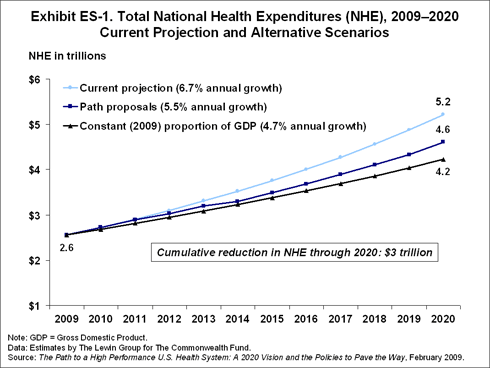
Designed to extend affordable insurance to everyone and create a foundation for essential payment and system reforms, the insurance framework would achieve near-universal coverage, ensure access and continuity, and lower premiums (Exhibit ES-2).
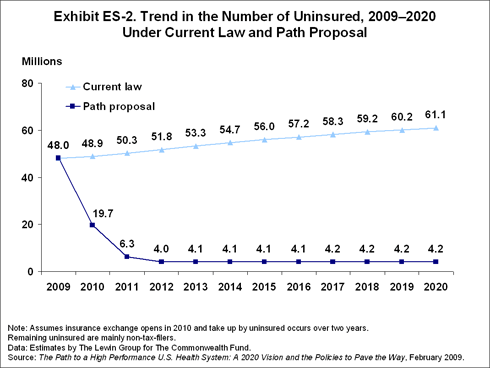
!!!PAGE BREAK!!!
The Commission's Strategic Vision
The Commission has identified five essential strategies for comprehensive reform:
- Affordable coverage for all.
- Align incentives with value and effective cost control.
- Accountable, accessible, patient-centered, and coordinated care.
- Aim high to improve quality, health outcomes, and efficiency.
- Accountable leadership and collaboration to set and achieve national goals.
Together, these strategies comprise the framework for this report with recommendations for policies that would move from concept to action.
Taking the Path: Commission Recommendations
The Commission offers the following set of recommendations to move onto a path to a high performance health system. The Commission believes all the recommendations are desirable, many necessary, but none on its own sufficient to achieve high performance. Designed to move forward quickly with a sense of urgency, the comprehensive reforms include significant changes that would introduce a new dynamic and more positive path over the next decade. With cost pressures mounting and coverage eroding, the stakes are high. Starting now is crucial.
1. Affordable Coverage for All: Ensure Access and Provide a Foundation for System Reform
To build on the current mixed private and public coverage system to extend affordable health insurance to all with a strategy designed to ensure access and continuity and provide a foundation for payment and system reforms, the Commission recommends policies that:
- Establish a health insurance exchange that offers an enhanced choice of private plans and a new public plan. This new public plan would offer comprehensive benefits with incentives for disease prevention and payment methods that reward results. It would build on Medicare's claims administrative structure and national provider networks. The exchange and new public plan would be open to all, including large employers.
- Require individuals to have coverage and employers to offer coverage or contribute to a trust fund for insurance, sharing responsibility to pay for insurance for all.
- Provide income-related premium assistance to make coverage affordable.
- Expand eligibility for and improve payment under Medicaid and the Children's Health Insurance Program to improve affordability and access. Eliminate Medicare's two-year waiting period for the disabled.
- Set a minimum benefit standard to ensure access and adequate protection from the financial burden of obtaining needed health care.
- Reform health insurance markets to improve insurance efficiency, access, and affordability by prohibiting premium variation based on health and guaranteeing offer and renewal of coverage to all regardless of health status.
By moving from fractured to continuous insurance coverage, these reforms would lower insurance administrative costs and provide a foundation for more coherent and effective payment and system reforms. All payment reforms would apply to current public programs (i.e., Medicare and Medicaid) and to the new public plan offered through the exchange to the under-65 population. Market reforms would focus competition among insurers on improving health outcomes and adding value. Businesses, patients, and families could choose among an array of national and regional private plans and the nationwide publicly sponsored option.
2. Aligned Incentives and Effective Cost Control: Payment Reform to Enhance Value
Change the way we pay for care to reward high quality and prudent stewardship of health care resources and to encourage reorganization of care so that it is well-coordinated and responsive to patients' needs. To move away from the current fee-for-service payment system toward one that emphasizes value rather than volume, the Commission recommends policies to:
- Strengthen and reinforce patient-centered primary care through enhanced payment of primary care services and changing the way we pay for primary care to encourage the adoption of the medical home model to ensure better access, coordination, chronic care management, and disease prevention.
- Promote more effective, efficient, and integrated health care delivery through adoption of more bundled payment approaches to paying for care over a period of time, with rewards for quality, outcomes, and patient-centered care, as well as rewards for efficiency tied to high performance.
- Correct price signals in health care markets to better align payments with value.
3. Accountable, Accessible, Patient-Centered, and Coordinated Care: Organize and Redesign the Delivery System to Improve Patient Experiences
Move from the current fragmented health care delivery system to one that is patient-centered, accessible, and organized so that patients and families can navigate care easily and one that holds providers accountable for high-quality, effective care across the continuum of care and over time. To move toward a delivery system in which everyone has a personal source of care that is accessible, coordinates care, and is accountable for obtaining the best health results, the Commission recommends policies that:
- Have patients designate a personal source of care that meets standards of accessibility, quality, and coordination and can serve as a medical home.
- Facilitate appropriate care and manage chronic conditions through integrated delivery systems that provide a continuum of care or provide funding and technical assistance for statewide and community efforts to support and connect primary care and more specialized resources in informal or virtual networks.
- Develop provisions in which providers participating in a hospital-physician organization receiving bundled payments would be eligible for medical liability coverage on favorable terms.
4. Improved Quality and Health Outcomes: Invest in Infrastructure and Public Health Policies
Invest in infrastructure to improve the availability, quality, and usefulness of information for health care decision-making by patients, providers, and payers and encourage a culture of continuous learning. To achieve these goals the Commission recommends actions that would:
- Accelerate adoption and use of health information technology (HIT) by establishing system standards, requiring electronic reporting of clinical information, and providing start-up funding for a national health information network so information follows the patient and is available to providers and patients.
- Support and inform better health care decision-making by establishing a Center for Comparative Effectiveness and Health Care Decision-Making, encouraging shared decision-making based on evidence, and using recommendations to develop value-based benefit designs that preserve choice but encourage appropriate care.
- Provide more transparent information to guide and drive innovation by requiring all-population, all-payer quality, patient experiences, and cost data with benchmarks of top performance.
Invest in improving population health with the goal of lowering the rates of preventable illness and improving health outcomes for chronic conditions with efforts to:
- Target public health initiatives on prevention of illness, including expansion of immunizations that are demonstrated as effective and public health actions and tax incentives and other initiatives to reduce obesity and decrease tobacco use and promote healthy lifestyles.
- Design health insurance benefits to encourage and support preventive care and essential care for chronic conditions, with positive incentives for patients to engage in health promotion and keep existing chronic conditions under control.
- Intensify the focus on preventing and managing chronic conditions, including incentives for more coordinated care and setting goals to improve outcomes for chronic conditions that account for the bulk of health care needs and spending.
5. Accountable Leadership and Collaboration: Coordinated Efforts to Improve the Health System
Leadership, new national policies, and collaboration among the public and private sectors will be necessary to set and achieve national goals for high performance. To provide accountable leadership and foster collaboration, the nation will need to establish mechanisms to set and achieve national goals, enable public programs to serve as prudent purchasers of care, and ensure coordination of practices and policies that cut across public programs and private sector activities. In addition to insurance reforms, we need national leadership to:
- Set performance targets and provide incentives and technical assistance to meet them.
- Authorize public programs, including Medicare, to be more active purchasers of high-value health care for their beneficiaries, rather than passive payers. This would include implementing and facilitating the adoption and rapid spread of innovative payment policies to elicit a more effective, efficient, and responsive delivery system.
- Establish a national insurance exchange that would operate at national, state, and regional levels to allow participation of regional private health plans and integrated delivery systems
- Establish a Center for Comparative Effectiveness and Health Care Decision-Making.
- Set national standards to accelerate adoption and use of health information technology and a national health information network.
!!!PAGE BREAK!!!
Estimated Impacts
Using a set of policies to illustrate concepts proposed by the Commission, this report analyzed the potential impact of those policies. The findings indicate that if all were implemented in 2010, it would be possible to extend affordable coverage to all and improve population health, while simultaneously reducing the growth in national health spending by a cumulative $3 trillion by 2020 compared with current projections.* This substantial sum is the accumulation of incremental savings each year, with a reduction in the projected annual rate of growth in national health expenditures from 6.7 percent to 5.5 percent. Notably, even after this substantial reduction, national health spending still would exceed the projected annual growth in gross domestic product (GDP). Although the percent of GDP spent on health care would be lower in 2020 than what is currently projected—18.4 percent of GDP compared with the projected 20.8 percent—it would account for a higher share of the U.S. economy than in 2009 (16.9 percent).
*These estimates are based on an extensive modeling effort by The Lewin Group. Lewin used specifications developed to reflect each component of the Commission’s recommendations. The results based on those specifications drew from available evidence as to their potential impact on those who would be affected and their behavioral responses. The Lewin Group is one of the leading health care and human services consulting firms in the United States, with more than 35 years of experience serving organizations in the public, nonprofit, and private sectors. The Lewin Group is a wholly owned subsidiary of Ingenix, which in turn is owned by UnitedHealth Group. The Lewin Group maintains editorial independence from its owners and is responsible for the integrity of any data that it produces for the Fund.
The policies included in the analysis interact and are mutually supporting. All contribute to the net cumulative effect on potential savings and improvement in value (Exhibit ES-3). Each slows the rate of growth in national health spending compared with current projections. (See summary for policies used for purposes of modeling coverage and cost estimates.)
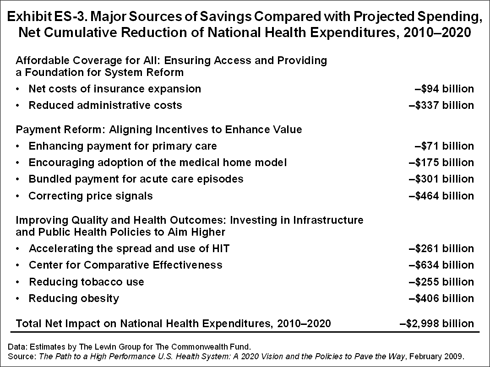
These estimated impacts are contingent on their effectiveness in stimulating change in the way providers, patients, and insurers (both public and private) behave, and how they react to the new opportunities the proposed policies would create. The Commission developed the set of policies with a vision of potential dynamic change—a chain of events that interact over time. A central feature is the insurance exchange structured to expand choice of plans in the context of market rules that prohibit competition on the basis of risk selection. This design could promote competition based on value to drive innovation among insurers and better organization of care. The public plan plays a central role in harnessing markets for positive change.
The effectiveness of these reforms depends on payers becoming more prudent purchasers. Transforming Medicare into a more active purchaser of care—with innovative payment methods that move away from fee-for-service to more bundled payments and mechanisms to hold providers accountable—could stimulate and support changes in behavior that improve performance. Comprehensive insurance with premium differences reflecting value and cost-sharing, aligned with effective care and better outcomes, would provide patients with incentives to seek high-value care and promote appropriate use of resources.
Success will require that key stakeholders join together to make difficult decisions and undertake the steps necessary to transform the health care delivery system and move along the path to high performance.
!!!PAGE BREAK!!!
Impact on Health Insurance Coverage
The insurance framework proposed by the Commission includes the creation of a new national insurance exchange that would offer private insurance plans and a new public plan option, expansion of existing public programs, market reforms, provisions for affordability, and requirements that all have coverage to reach universal participation. By establishing a new public plan available nationwide, the framework would also provide the basis for a new competitive dynamic in insurance markets and provide a strong foundation for payment and system reforms.
The insurance expansion would achieve near-universal coverage. The number of uninsured would drop from an estimated 48 million in 2009 (16 percent of the U.S. population) to 4 million by 2012 (1 percent of the population), with nearly everyone insured over the next decade (Exhibit ES-2). Absent new directions, the number of uninsured is projected to rise to 61 million or more by 2020.
By building on existing insurance coverage, this framework would permit individuals to keep their current coverage if it works for them while providing new choices through the insurance exchange, including a range of private plans and the new public plan. Small employers in particular would be able to offer their employees a choice of multiple plans. Large employers would gain a nationwide plan plus employee choice of regional plans. All those enrolled through the exchange would be able to keep their coverage as jobs or circumstances changed. The exchange could be open in stages to allow reasonable time to set up. In the modeling, the exchange starts out by opening to small firms and individuals, opens to midsized companies in two years, and opens to all employers by 2014. With the advantages of continuity and choice, including a public plan option, the modeling estimates that over time most of the privately insured market (about two-thirds) would elect to receive coverage through the exchange.
The new public plan option would provide a less expensive alternative for the uninsured and underinsured than what is currently available in the individual and small business insurance markets. Savings would derive from significantly lower administrative costs and use of Medicare's reformed provider payment rates. Estimates indicate premiums for the public plan would be at least 20 percent below those currently available for a comparable benefit package in the private market (Exhibit ES-4). The availability of the public plan option would thus provide a catalyst for private plans to innovate and reexamine the way they operate and pay for care.
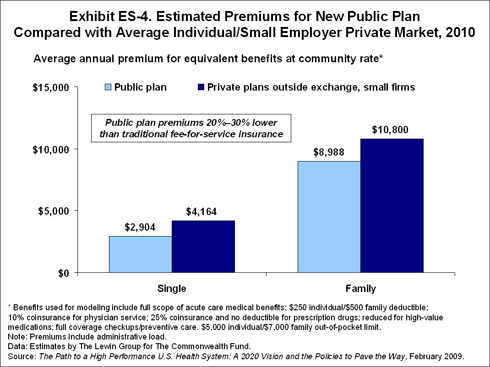
With the flexibility to establish more integrated care networks and a variety of payment policies, private plans—by focusing on quality and value—could compete with each other and outperform the public plan, if they innovate. Provisions could encourage multipayer synchronization to ensure coherent policies and reduce administrative complexity. The goal is more vigorous, innovative, and value-driven competition focused on outcomes and a more streamlined, efficient health insurance financing system.
Impact on Care, Quality, and Outcomes
Changing the way we pay for care to align incentives with value is critical. The payment reforms proposed by the Commission would enhance the value of primary care and change the way we pay to stimulate care delivery through patient-centered medical homes with the capacity to provide access, coordinate care, and use information systems and teams to manage chronic conditions. Moving to more bundled payments, with provisions for accountability for outcomes, would align incentives with the value rather than volume of care delivered and would support hospitals, physicians, and other clinicians working together to care for patients. Building a solid infrastructure of information systems and programs to enhance prevention of disease and promote population health would emphasize innovation to meet current and future community health needs.
The Commission envisions a health system that provides patients with personal sources of care who know their medical history, ensures timely access, helps coordinate care, and uses essential clinical information to provide the right care with an emphasis on health and disease prevention. Payment and information systems would stimulate and support a patient-centered care system that is coordinated, accessible, and safe.
With a focus on prevention and improving outcomes for chronic disease, the nation could achieve substantial improvements in population health with policies that align incentives with the provision of right care and prudent use of resources, provide clinicians with information system tools and decision support, and build and expand public health programs. We should aim for healthier, more productive lives through prevention of disease, earlier intervention, and effective management of chronic conditions, including people with multiple comorbidities. In addition, more effective and humane care for people with late-stage diseases could address the huge variations in care.
By setting targets and implementing policies that meet and raise benchmarks of top performance, we have the opportunity to save lives, improve the quality of life and care experience, lower safety risks to patients, and prevent the onset of disease and complications. As illustrated by key indicators from the Commission's National Scorecard on U.S. Health System Performance, improving average performance to targets or benchmarks set by current top performers by 2020 would achieve substantial gains in population health and patient experiences (Exhibit ES-5).

!!!PAGE BREAK!!!
Impact on Providers
While slowing expenditure growth to 5.5 percent per year is a significant change from recent years, hospitals, physicians, and other providers' revenues would continue to experience growth each year. This growth would be only marginally slower than what is currently projected, as revenues continue to increase due to medical advances and an aging population (Exhibit ES-6). Payment reforms would support and provide incentives for practice innovations and more productive resource use.
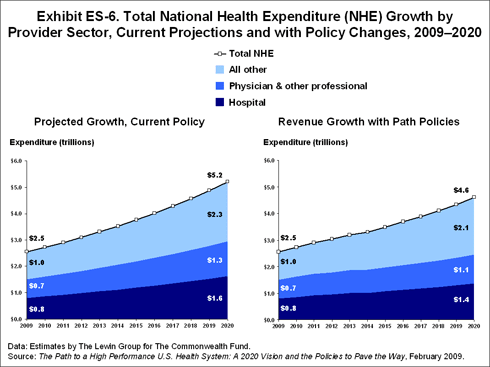
Distribution of Impact Across Major Payer Groups
All major sectors would benefit from improved health and from slower growth in spending, compared with projected trends. By 2020, the cumulative reduction in the growth of national health spending compared with trends of $3 trillion would be distributed across the major groups that pay for health care: the federal, state, and local governments; private employers; and households (Exhibit ES-7).
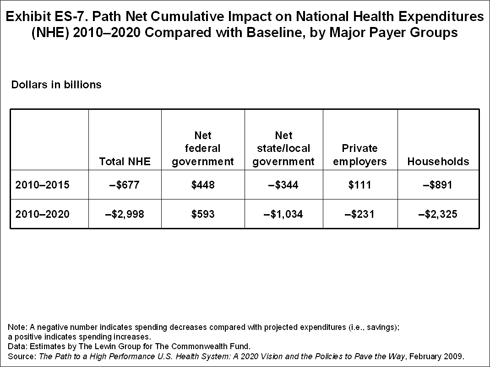
Most of the savings would accrue to individuals and families as a result of slower growth in premiums and out-of-pocket spending, federal premium assistance, and expansion of public programs to make insurance affordable. The savings would accrue across all income groups, including higher-income households. State and local governments would also realize substantial savings relative to current projections.
Employers who currently provide insurance and their employees would also realize significant savings as a result of lower premiums and more equitable sharing of the costs of family coverage across all employers. Over time, new system savings would offset costs for employers and workers as premium growth slows, with net cumulative employer savings of $231 billion by 2020.
As the central source of financing for coverage expansions, the federal government's costs would increase during early years to make coverage affordable. The insurance design specified for modeling also provides federal funding to offset state and local costs of expanding Medicaid and raising Medicaid payment rates to Medicare levels. As a result, there would be an increase in net federal government spending during the decade. With system reform policies in place, however, the net federal cost of insurance expansion and investing in the care system declines rapidly. By 2020, payment and system reform savings would offset nearly all the increase in annual federal spending compared with baseline projections (Exhibit ES-8). Over the 2010 to 2020 period, the net federal budget outlays are estimated to be $593 billion—with most incurred in the first five years.

The Commission did not specify a plan to finance the federal expansion. As the report discusses, there are a number of ways to pay for such costs, with net gains to all as the nation invests in a healthier and more secure future. As state governments, households, and employers all save significantly, policies could recapture some of the savings or modify design features to finance federal support of insurance for all.
!!!PAGE BREAK!!!
Conclusions
Moving forward on a comprehensive reform agenda and making significant progress quickly require major changes. In a care system that touches so many lives and generates over $2 trillion in revenue per year, such changes will be very difficult to make. Yet, if we fail to act now with bold reforms, the situation we face in the future will be much worse.
The insurance design, including the exchange and new public plan, seeks a dynamic, competitive strategy that retains a mixed private and public insurance system, with the best of what each sector has to offer. The challenge will be achieving a balance in which the public and private plans compete within market rules or regulations that stimulate innovation and outcomes in the public interest. It will be important to develop a mechanism to set the price point and payment policies in a nonarbitrary fashion. The goal should be to provide incentives and support for high-quality and efficient care systems, with rational public and private insurance payment policies. The Commission will continue to explore and address this issue in upcoming reports.
It will take time and flexibility to develop innovative payment reforms to stimulate the kinds of delivery system changes needed. Currently, public programs like Medicare, the Civilian Health and Medical Program of the Uniformed Services, and the Federal Employees Health Benefits Program set payment policies in multiple ways. If the new public plan and Medicare are to support improved performance, they will need the authority and flexibility to act on behalf of beneficiaries, with targets set by Congress and the President. This will also require accountability for preserving and enhancing access and health outcomes. A new national health council, Medicare board, or other mechanism will be necessary to enable Medicare and the new public plan to serve as prudent purchasers, to facilitate and spread innovative payment policies, and to collaborate with private and other public payers within a multipayer system.
Significant reform will also be needed to change the way we pay for care to focus on value and to set up a national exchange in which all insurers agree to accept everyone and charge the same premium, regardless of health. Providing positive incentives for patients to seek high-quality, effective care and assess alternatives will require investment in information systems, public reporting, and support for evidence-based medicine and mechanisms for applying that evidence.
Overall, moving on a path to high performance will require that we, as a nation, reach consensus that the status quo is not acceptable. It will require bold action on behalf of the greater good of the population, health outcomes, and economic security. Successful implementation of effective policies will require leadership with authority to act and collaboration across sectors to achieve targets and goals.
The results presented in this report underscore several key themes and build on the Commission's earlier analysis of strategies to achieve a high performance system:
- We should aim high. Better access and health outcomes, along with slower cost growth, are possible. It is urgent to start now. The consequences of maintaining the status quo—in terms of both human and economic costs—put the nation at risk. Early action has the potential for substantial cumulative benefits. Delay increases the magnitude of the problems. We cannot afford to continue on our current path.
- A comprehensive system approach is essential. We need to simultaneously expand coverage and take bold action to improve quality and efficiency. There is no "magic bullet" that can alone address rising costs, access, and quality. A coherent set of policies aimed at misaligned incentives, an information deficit, and structural flaws that drive costs up and drag outcomes down is necessary to improve.
- Better information is a key to improved performance. We need to invest for the future. Improving the health system requires a clinical information system to support patients and clinicians; better evidence on the effectiveness of treatments, drugs, and devices; and information to compare performance at the national, community, and provider levels.
- Insurance provides an essential foundation for payment and system reforms. If designed to ensure access and improve insurance efficiency, coverage expansion provides a base for payment and system changes that create more consistent signals and drive delivery systems to higher performance. Benefit design can provide incentives for preventive care and essential care for chronic disease. Less fragmented coverage enables purchasing leverage for change. Universal coverage, coupled with payment and system reforms, would provide a catalyst for significant gains in value.
- Value means more than savings. Higher value includes improvements in quality, equity, access, and healthy lives, in addition to savings. The potential to improve health outcomes, not just savings, should drive decisions for the future.
- Achieving high performance will require all stakeholders to take part in solutions and come together to focus on the gains for patients and the nation. Expanding coverage to everyone, improving performance, and achieving national health system savings will not be easy. It will require a shift in the way we pay for and deliver care, as well as major insurance reforms. Payers and providers must address current payment inequities and reach consensus on reforms to support efficient, high-value care.
- Leadership is critical. Building consensus requires leadership and public-private collaboration. Successful implementation of effective policies requires leadership with authority to act and collaboration across sectors to achieve targets and goals.
As a nation, we all gain by moving in new directions to expand coverage and implement payment and system reforms, with a focus on improving health, patient experiences, and value. The stakes are high if we fail to act.
Windows of opportunity for real health reform do not stay open for long. While the challenge is daunting, it is imperative that our new federal leadership move swiftly to change direction and put the U.S. health system on the path to high performance.
Summary of Policy Modeling Specifications for Coverage and Cost Estimates
Coverage
- National Health Insurance Exchange. Offers businesses and individuals a choice of private plans and a new public plan, phased in by size of firm with all eligible by 2014. Premium of the public plan would be community rated within broad age bands. Benefits are similar to the standard option in the Federal Employees Health Benefits Program. The plan would use Medicare's claims administrative structure and reformed payment methods and rates.
- Individual Mandate. All individuals are required to obtain coverage.
- Affordability. Premiums are capped at 5 percent of income for low-income individuals and 10 percent of income for those in higher-income tax brackets.
- Shared Financial Responsibility. Employers are required to provide coverage or contribute to a trust fund. The example used in the model included 7 percent of payroll, up to $1.25 an hour.
- Medicaid/SCHIP Expansion. All individuals with incomes up to 150 percent of the federal poverty income level are eligible for Medicaid acute care benefits. Medicaid provider payment rates are raised to Medicare levels. The federal matching rate is increased to offset state costs.
- Medicare. The two-year waiting period for coverage of the disabled is eliminated. Medicare beneficiaries are offered a supplement with the same acute care benefits as in new public plan and premium affordability provisions.
- Insurance Market Reforms. Require community-rate premiums (age bands permitted) and guaranteed issue and renewal of policies. Premium and insurance information would be publicly available on the Web.
Payment Reform: Aligning Incentives to Enhance Value
- Enhance Payment for Primary Care. Increase Medicare payments for primary care by 5 percent and apply differential updates for primary care and other care.
- Encourage Development and Spread of Patient-Centered Medical Homes. Provide payment per patient in addition to fee-for-service to practices qualified to provide patient-centered care. Reduced premiums and cost-sharing available to patients who designate a primary care practice as their medical home. Shared savings would be distributed on the basis of performance.
- Bundled Payments for Acute Care Episodes. Expand acute care payment to include services during the hospital stay and 30 days post-discharge in a global fee. The policy would be phased in, starting with inpatient services in 2010, then post-acute care in 2013, and hospital inpatient and outpatient physician care in 2016.
- Correcting Price Signals. Modify payments by: 1) slowing the rate of Medicare payment updates in geographic areas with high costs; 2) reducing prescription drug costs by having Medicare pay Medicaid prices for drugs used by dually eligible beneficiaries and determining Medicare payments for unique drugs with effective monopolies based on prices paid in other countries; and 3) resetting benchmarks for Medicare Advantage plans in each county to projected per-capita spending under traditional Medicare.
Investing in Information Infrastructure
- Accelerate the Adoption and Use of Health Information Technology. Require all providers to report key health outcomes electronically by 2015 to qualify for payment updates. Provide funding to support health information networks and assistance for safety-net providers and small practices through a 1 percent assessment on insurance premiums and Medicare outlays.
- Center for Medical Effectiveness and Health Care Decision-Making. Create a mechanism to develop information on the clinical and cost-effectiveness of alternative treatment options. Fund the Center with a .05 percent assessment on insurance premiums and Medicare and Medicaid spending. Use the information in benefit designs with higher out-of-pocket costs or differential pricing depending on comparative effectiveness and include physician-patient shared decision-making.
Promoting Health and Disease Prevention
- Reduce Tobacco Use. Increase federal taxes on tobacco products by $2 per pack of cigarettes. Use revenues to fund public health programs and insurance expansion.
- Reduce Obesity and Alcohol Use. Establish a new tax on sugar-sweetened soft drinks of 1 cent per 12-ounces to finance state obesity prevention programs, and increase the federal excise tax on alcohol by 5 cents per 12-ounce can of beer, with proportionate increases on other alcohol products. Use funds for prevention and insurance expansion.
| Methodology Note: Modeling the Commission recommendations required detailed specifications for each of the policy approaches. The above specifications were used for illustrative purposes. Recognizing that multiple policy variations are feasible for key policy reforms, the Commission endorses the strategic approaches rather than the specific policy parameters used to model potential effects. The main report provides further detail. The Lewin Group technical report, The Path to a High Performance U.S. Health System: Technical Documentation, is available online at www.Lewin.com for data and parameters used to estimate 2010–2020 impacts. |